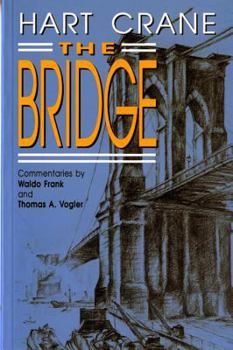Bridge: A Poem (Revised)
Select Format
Select Condition 
Book Overview
Begun in 1923 and published 1930, The Bridge is Crane's major work. "Very roughly," he wrote a friend, "it concerns a mystical synthesis of 'America' . . . The initial impulses of 'our people' will have to be gathered up toward the climax of the bridge, symbol of our constructive future, our unique identity."
Format:Paperback
Language:English
ISBN:0871402254
ISBN13:9780871402257
Release Date:July 1992
Publisher:Liveright Publishing Corporation
Length:114 Pages
Weight:0.32 lbs.
Dimensions:0.3" x 5.0" x 7.7"
Customer Reviews
2 ratings
A Visionary American Poem
Published by Thriftbooks.com User , 18 years ago
I have been reading the Library of America's newly-published edition of Hart Crane's (1899- 1932) complete poems. The LOA edition includes as well over 400 of Crane's letters to his family, friends, and associates. The LOA compilation of Hart Crane's writings made me want to turn again, specifically to his masterpiece, "The Bridge". I have owned the paperback edition of "The Bridge", reviewed here, for many years. It has the advantage over the LOA edition in being less bulky and in including two thoughtful introductions to help approach this difficult poem. The first introduction is by Crane's friend, the poet and critic Yvor Winters. Winters's article dates from 1932, and it is critical of "The Bridge". The second review is by Thomas Vogler. It dates from the 1970s, when this paperback was first published, and attempts to answer some of Frank's objections to the poem. The reader will need to respond to the poem for himself or herself. But I find both Winters's and Vogler's reviews suggestive and illuminating. Crane first conceived the project of a long poem on the Brooklyn Bridge in 1923. He worked on it fitfully for six years completing in in 1929. The poem was published in 1930. Crane received financial assistance from the philanthropist Otto Kahn (1867 -- 1934) to allow him to work on "The Bridge". We are forever in Kahn's debt. Crane's work on the poem was hindered by the complexity of its themes and by severe excesses in his personal life. But Crane persevered and was able to realize his project. Crane committed suicide in 1932. A difficult and still controversial work, the Bridge has won an important place in American literature. More than that, it has long won a place in my heart. Hart Crane wrote "The Bridge" as an answer to the pessimism and despair of T.S. Eliot's poem "The Waste Land." Crane wanted to create a vision of hope for modern life and a secular myth for the United States. He tried to do so by using the magnificent Brooklyn Bridge, engineered by Washington Roebling, as a symbol. By coincidence, Crane lived for some years in a small room in Brooklyn Heights from which he could see the Brooklyn Bridge. Roebling had also lived in this same room. In Crane's poem, the Brooklyn Bridge is a symbol of power and industrialization and of the promise it offers to modern life. But it is infinitely more. The arch of the bride, in Crane's mythology, stretches backwards in time to the discovery of America, and further. The Bridge also stretches in space to encompass the continent in its entirety, the West, and, particularly the Mississippi River. The Brooklyn Bridge becomes, in Crane's myth, a transcendent symbol in which distinctions of time and place are oblisterated in a mystic vision of self and of the United States. The myth of the poem is also highly personal, as the poet tries to come to terms with his life. In the journey of the poem, the poet leaves his lover in bed in the morning to cross the bridge. He v
not easy poetry, but worth the struggle
Published by Thriftbooks.com User , 27 years ago
I'd suggest reading Samuel R. Delany's essay (in Longer Views) and accidentally catching a program on PBS about Hart Crane after your first read of it. It helped me tremendously. An epic poem which explores America, "modern" poetic imagery (the Brooklyn bridge as opposed to a tree), Columbus, Whitman, Poe, Pocahontas, and sea imagery. It also contains very bold (for the pre-Stonewall era) allusions to homosexuality, in the typical method of the period which is rooted in gender-neutrality.






